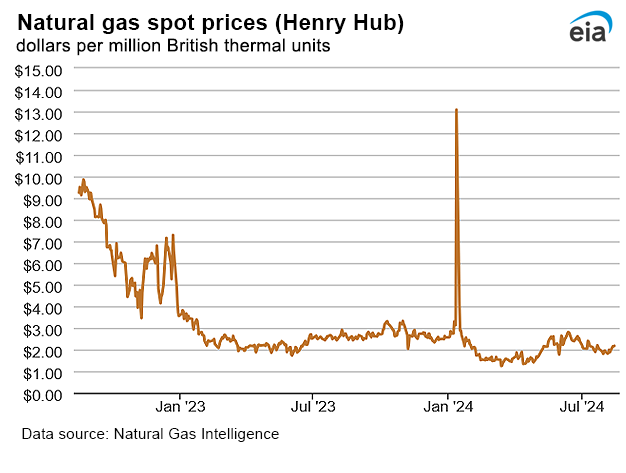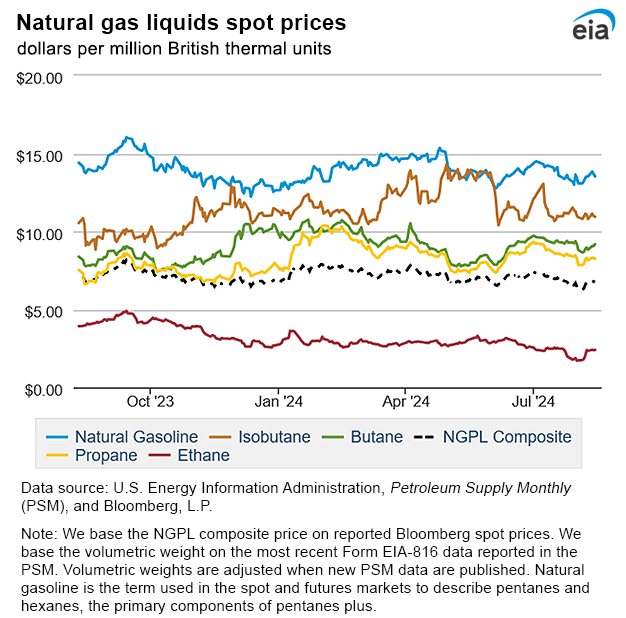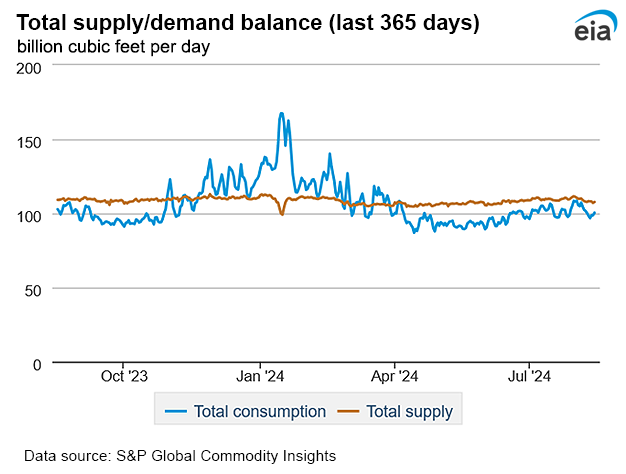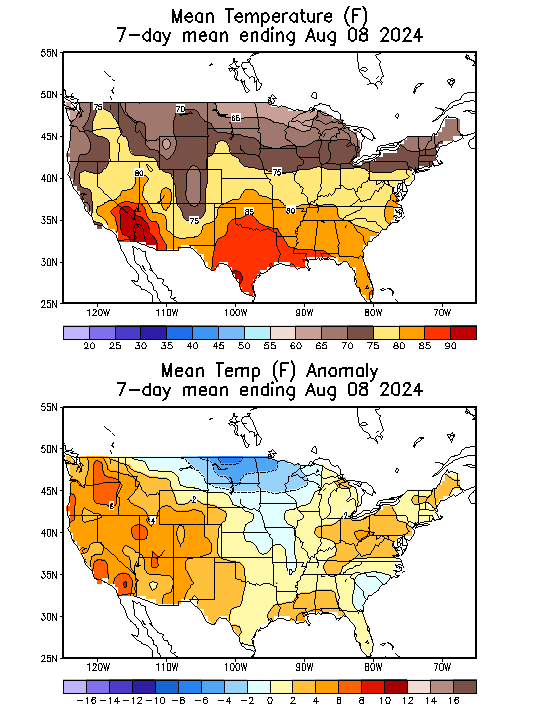Today in Energy
Recent Today in Energy analysis of natural gas markets is available on the EIA website.
Market Highlights:
(For the week ending Wednesday, August 14, 2024)Prices
- Henry Hub spot price: The Henry Hub spot price rose 18 cents from $1.99 per million British thermal units (MMBtu) last Wednesday to $2.17/MMBtu yesterday.
- Henry Hub futures price: The price of the September 2024 NYMEX contract increased 10.7 cents, from $2.112/MMBtu last Wednesday to $2.219/MMBtu yesterday. The price of the 12-month strip averaging September 2024 through August 2025 futures contracts rose 8.1 cents to $3.020/MMBtu.
- Select regional spot prices: Natural gas spot price changes were mixed this report week (Wednesday, August 7, to Wednesday, August 14), increasing in the Midwest and Northeast and decreasing on the West Coast. Price changes ranged from a decrease of 44 cents at Northwest Sumas to an increase of 25 cents at the Algonquin Citygate.
- Prices in the Northeast rose this report week. At the Algonquin Citygate, which serves Boston-area consumers, the price rose 25 cents from $1.48/MMBtu last Wednesday to $1.73/MMBtu yesterday. At Eastern Gas South in southwest Pennsylvania, near Appalachia region production activities, the price increased 23 cents from $1.34/MMBtu last Wednesday to $1.57/MMBtu yesterday. Natural gas production in the Appalachia region decreased 2% (0.8 billion cubic feet per day [Bcf/d]) to 34.1 Bcf/d this report week, according to data from S&P Global Commodity Insights. At the same time, natural gas consumption in the electric power sector decreased 20% (2.7 Bcf/d), as normal to below-normal temperatures moved into the region. Temperatures in the Boston Area averaged a near-normal 74°F this week, which resulted in 63 cooling degree days (CDDs), 24 fewer CDDs than last week. Temperatures in the Pittsburgh Area averaged 71°F, which was 7°F lower than the previous week, resulting in 45 fewer CDDs than last week and 8 fewer than normal.
- Prices on the West Coast decreased this report week. The price at PG&E Citygate in Northern California fell 29 cents from $3.05/MMBtu last Wednesday to $2.76/MMBtu yesterday. The price at SoCal Citygate in Southern California decreased 30 cents from $2.29/MMBtu last Wednesday to $1.99/MMBtu yesterday. At Northwest Sumas on the Canada-Washington border, the main pricing point for natural gas in the Pacific Northwest, the price fell 44 cents from $1.48/MMBtu last Wednesday to $1.04/MMBtu yesterday. Natural gas consumption in the Western region decreased 9% (1.0 Bcf/d), according to data from S&P Global Commodity Insights, which was driven by a 25% (0.6 Bcf/d) decrease in consumption in the electric power sector in California. Temperatures in the Riverside Area, east of Los Angeles, averaged 83°F this report week, resulting in 125 CDDs, 25 fewer CDDs than last week but 21 more than normal.
- The price at the Waha Hub in West Texas, which is located near Permian Basin production activities, increased 1 cent from -$0.38/MMBtu last Wednesday to -$0.37/MMBtu yesterday. The Waha Hub traded $2.55 below the Henry Hub price yesterday, compared with last Wednesday when it traded $2.36 below the Henry Hub price. The Waha Hub has been below zero frequently since March and settled at its second-lowest price this year of -$4.25/MMBtu on August 9, which was the fourth lowest price since April 3, 2012, when the price was -$5.75/MMBtu. Relatively high production in the Permian Basin and pipeline maintenance have contributed to sub-zero prices at the Waha Hub this year. From January 1 through August 8, natural gas production in the Permian Basin averaged 19.0 Bcf/d compared with 18.4 Bcf/d during the second half of 2023, according to data from S&P Global Commodity Insights. In addition, maintenance this week on the El Paso Natural Gas North Mainline, which transports natural gas westbound from the Permian Basin, reduced available pipeline capacity by an additional 0.6 Bcf/d from August 6 to August 9.
- International futures prices: International natural gas futures prices increased this report week. According to Bloomberg Finance, L.P., weekly average front-month futures prices for liquefied natural gas (LNG) cargoes in East Asia increased 12 cents to a weekly average of $12.62/MMBtu. Natural gas futures for delivery at the Title Transfer Facility (TTF) in the Netherlands increased 98 cents to a weekly average of $12.76/MMBtu. In the same week last year (week ending August 16, 2023), the prices were $11.76/MMBtu in East Asia and $11.75/MMBtu at TTF.
- Natural gas plant liquids (NGPL) prices: The natural gas plant liquids composite price at Mont Belvieu, Texas, rose by 37 cents/MMBtu, averaging $6.76/MMBtu for the week ending August 14. Ethane prices rose 32% week over week, while weekly average natural gas prices at the Houston Ship Channel increased 5%, widening the ethane premium to natural gas by 858%. The ethylene spot price rose 5% week over week, and the ethylene premium to ethane was essentially unchanged. Propane prices increased 3%, while Brent crude oil prices rose 4%, widening the propane discount to crude oil by 5% for the week. Normal butane prices rose 2%, isobutane prices were essentially unchanged, and natural gasoline prices rose 3%.
Daily spot prices by region are available on the EIA website.
Supply and Demand
- Supply: According to data from S&P Global Commodity Insights, the average total supply of natural gas fell by 1.8% (2.0 Bcf/d) compared with the previous report week. Dry natural gas production decreased by 1.4% (1.5 Bcf/d) to average 101.3 Bcf/d, and average net imports from Canada decreased by 7.7% (0.5 Bcf/d) from last week.
- Demand: Total U.S. consumption of natural gas fell by 8.1% (6.4 Bcf/d) compared with the previous report week, according to data from S&P Global Commodity Insights. Natural gas consumed for power generation declined by 11.8% (5.8 Bcf/d) week over week, driven by below-average temperatures for most of the northern United States. Industrial sector consumption increased by 0.1% (less than 0.1 Bcf/d), and residential and commercial sector consumption declined by 7.1% (0.6 Bcf/d). Natural gas exports to Mexico increased 1.1% (0.1 Bcf/d). Natural gas deliveries to U.S. LNG export facilities (LNG pipeline receipts) averaged 12.6 Bcf/d, essentially the same as last week.
Liquefied Natural Gas (LNG)
- Pipeline receipts: Average natural gas deliveries to U.S. LNG export terminals were essentially unchanged from last week at 12.6 Bcf/d, according to data from S&P Global Commodity Insights. Natural gas deliveries to terminals in South Louisiana decreased by 0.2% (less than 0.1 Bcf/d) to 7.3 Bcf/d, while natural gas deliveries to terminals in South Texas were essentially unchanged at 4.4 Bcf/d. Natural gas deliveries to terminals outside the Gulf Coast were essentially unchanged.
- Vessels departing U.S. ports: Twenty LNG vessels (seven from Sabine Pass, four each from Corpus Christi and Freeport, three from Cameron, and one each from Calcasieu Pass and Cove Point) with a combined LNG-carrying capacity of 74 Bcf departed the United States between August 8 and August 14, according to shipping data provided by Bloomberg Finance, L.P.
Rig Count
- According to Baker Hughes, for the week ending Tuesday, August 6, the natural gas rig count decreased by 1 rig from a week ago to 97 rigs. The Marcellus added one rig and one rig was added among unidentified producing regions, while the Haynesville dropped two rigs and the Utica dropped one rig. The number of oil-directed rigs increased by 3 rigs from a week ago to 485 rigs. The DJ-Niobrara and the Permian each added one rig, and one rig was added among unidentified producing regions. The total rig count, which includes 6 miscellaneous rigs, now stands at 588 rigs, 66 fewer rigs than a year ago.
Storage
- Net withdrawals from storage totaled 6 Bcf for the week ending August 9, compared with the five-year (2019–2023) average net injections of 43 Bcf and last year's net injections of 33 Bcf during the same week. Working natural gas stocks totaled 3,264 Bcf, which is 375 Bcf (13%) more than the five-year average and 209 Bcf (7%) more than last year at this time.
- According to The Desk survey of natural gas analysts, estimates of the weekly net change to working natural gas stocks ranged from net withdrawals of 12 Bcf to net injections of 23 Bcf, with a median estimate of net withdrawals of 2 Bcf.
- The average rate of injections into storage is 21% lower than the five-year average so far in the refill season (April through October). If the rate of injections into storage matched the five-year average of 9.9 Bcf/d for the remainder of the refill season, the total inventory would be 4,087 Bcf on October 31, which is 375 Bcf higher than the five-year average of 3,712 Bcf for that time of year.
See also:
Top
| Spot Prices ($/MMBtu) | Thu, 08-Aug |
Fri, 09-Aug |
Mon, 12-Aug |
Tue, 13-Aug |
Wed, 14-Aug |
|---|---|---|---|---|---|
| Henry Hub |
1.87 |
1.96 |
2.15 |
2.15 |
2.17 |
| New York |
1.35 |
1.45 |
1.47 |
1.61 |
1.63 |
| Chicago |
1.70 |
1.78 |
1.80 |
1.77 |
1.84 |
| Cal. Comp. Avg.* |
2.15 |
2.06 |
2.15 |
2.02 |
2.06 |


| U.S. natural gas supply - Gas Week: (8/8/24 - 8/14/24) | |||
|---|---|---|---|
Average daily values (billion cubic feet) |
|||
this week |
last week |
last year |
|
| Marketed production | 114.7 |
116.3 |
115.8 |
| Dry production | 101.3 |
102.8 |
103.1 |
| Net Canada imports | 6.4 |
7.0 |
5.7 |
| LNG pipeline deliveries | 0.1 |
0.1 |
0.1 |
| Total supply | 107.8 |
109.8 |
108.9 |
|
Data source: S&P Global Commodity Insights | |||
| U.S. natural gas consumption - Gas Week: (8/8/24 - 8/14/24) | |||
|---|---|---|---|
Average daily values (billion cubic feet) |
|||
this week |
last week |
last year |
|
| U.S. consumption | 73.1 |
79.6 |
77.6 |
| Power | 43.7 |
49.5 |
47.5 |
| Industrial | 21.5 |
21.5 |
22.1 |
| Residential/commercial | 7.9 |
8.6 |
8.0 |
| Mexico exports | 6.9 |
6.8 |
7.0 |
| Pipeline fuel use/losses | 6.7 |
6.9 |
7.0 |
| LNG pipeline receipts | 12.6 |
12.6 |
12.2 |
| Total demand | 99.2 |
105.9 |
103.8 |
|
Data source: S&P Global Commodity Insights | |||


| Rigs | |||
|---|---|---|---|
Tue, August 06, 2024 |
Change from |
||
|
last week
|
last year
|
||
| Oil rigs |
485
|
0.6%
|
-7.6%
|
| Natural gas rigs |
97
|
-1.0%
|
-21.1%
|
| Note: Excludes any miscellaneous rigs | |||
| Rig numbers by type | |||
|---|---|---|---|
Tue, August 06, 2024 |
Change from |
||
|
last week
|
last year
|
||
| Vertical |
17
|
0.0%
|
-22.7%
|
| Horizontal |
521
|
0.2%
|
-10.0%
|
| Directional |
50
|
2.0%
|
-5.7%
|
| Data source: Baker Hughes Company | |||
| Working gas in underground storage | ||||
|---|---|---|---|---|
Stocks billion cubic feet (Bcf) |
||||
| Region |
2024-08-09 |
2024-08-02 |
change |
|
| East |
723 |
719 |
4 |
|
| Midwest |
869 |
854 |
15 |
|
| Mountain |
260 |
257 |
3 |
|
| Pacific |
287 |
289 |
-2 |
|
| South Central |
1,125 |
1,152 |
-27 |
|
| Total |
3,264 |
3,270 |
-6 |
|
|
Data source: U.S. Energy Information Administration Form EIA-912, Weekly Underground Natural Gas Storage Report
Note: Totals may not equal sum of components because of independent rounding. | ||||
| Working gas in underground storage | |||||
|---|---|---|---|---|---|
Historical comparisons |
|||||
Year ago 8/9/23 |
5-year average 2019-2023 |
||||
| Region | Stocks (Bcf) |
% change |
Stocks (Bcf) |
% change |
|
| East |
712 |
1.5 |
658 |
9.9 |
|
| Midwest |
807 |
7.7 |
765 |
13.6 |
|
| Mountain |
200 |
30.0 |
181 |
43.6 |
|
| Pacific |
238 |
20.6 |
263 |
9.1 |
|
| South Central | 1,097 |
2.6 |
1,021 |
10.2 |
|
| Total | 3,055 |
6.8 |
2,889 |
13.0 |
|
| Data source: U.S. Energy Information Administration Form EIA-912, Weekly Underground Natural Gas Storage Report
Note: Totals may not equal sum of components because of independent rounding. |
|||||
| Temperature – heating & cooling degree days (week ending Aug 08) | ||||||||
|---|---|---|---|---|---|---|---|---|
HDDs |
CDDs |
|||||||
| Region | Current total |
Deviation from normal |
Deviation from last year |
Current total |
Deviation from normal |
Deviation from last year |
||
| New England | 2 |
0 |
0 |
53 |
10 |
20 |
||
| Middle Atlantic | 0 |
-3 |
0 |
69 |
12 |
19 |
||
| E N Central | 1 |
-3 |
0 |
65 |
11 |
19 |
||
| W N Central | 4 |
1 |
3 |
66 |
-1 |
4 |
||
| South Atlantic | 0 |
0 |
0 |
108 |
13 |
12 |
||
| E S Central | 0 |
0 |
0 |
107 |
14 |
14 |
||
| W S Central | 0 |
0 |
0 |
136 |
12 |
-21 |
||
| Mountain | 1 |
-2 |
0 |
95 |
21 |
19 |
||
| Pacific | 0 |
-2 |
0 |
76 |
29 |
24 |
||
| United States | 1 |
-2 |
0 |
87 |
14 |
13 |
||
|
Data source: National Oceanic and Atmospheric Administration Note: HDDs=heating degree days; CDDs=cooling degree days | ||||||||
Average temperature (°F)
7-day mean ending Aug 08, 2024

Data source: National Oceanic and Atmospheric Administration
Deviation between average and normal temperature (°F)
7-day mean ending Aug 08, 2024

Data source: National Oceanic and Atmospheric Administration
Monthly U.S. dry shale natural gas production by formation is available in the Short-Term Energy Outlook.
